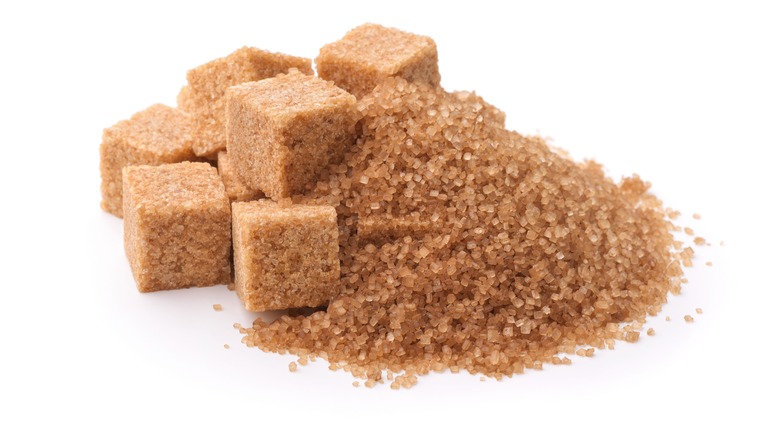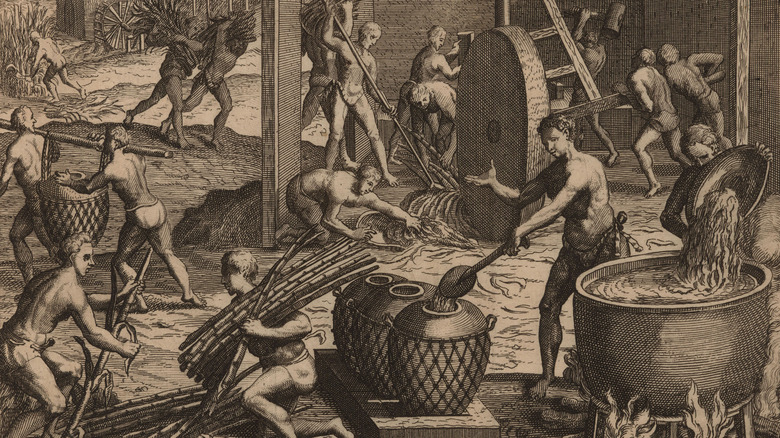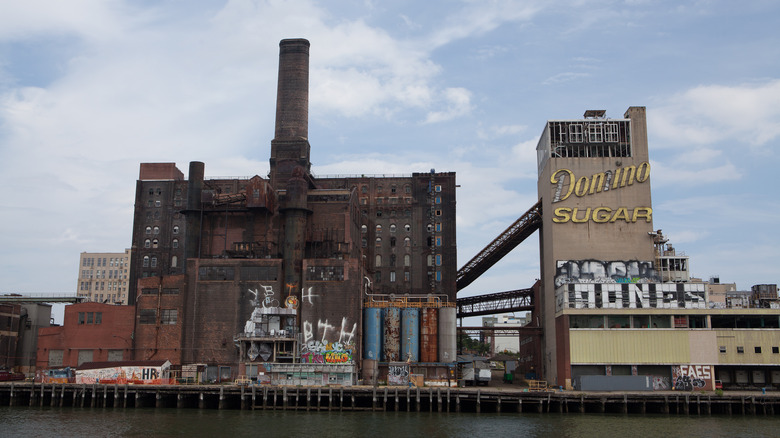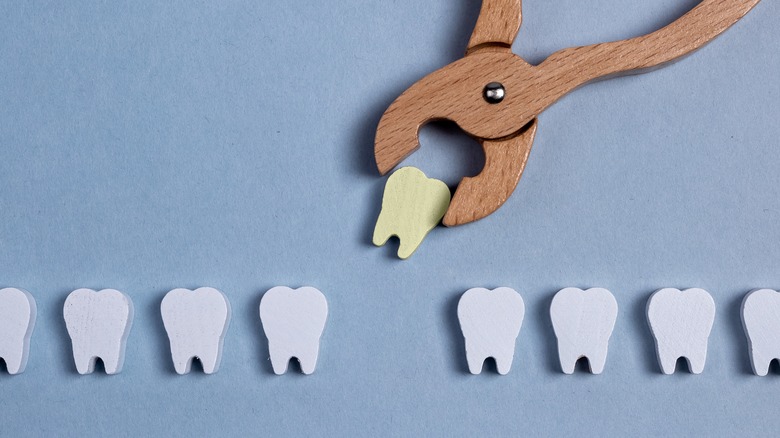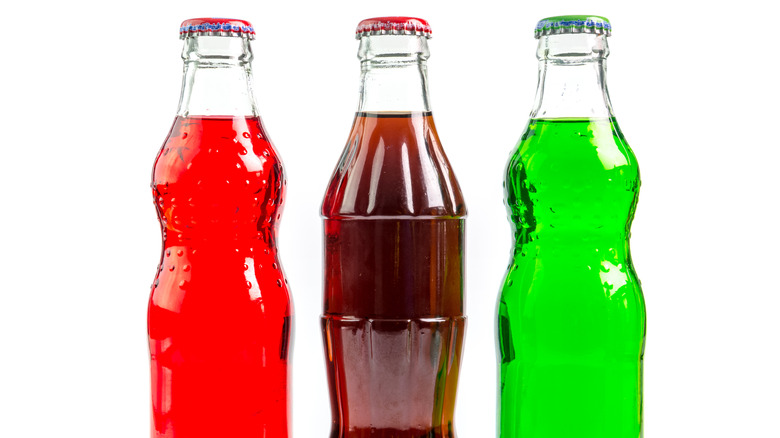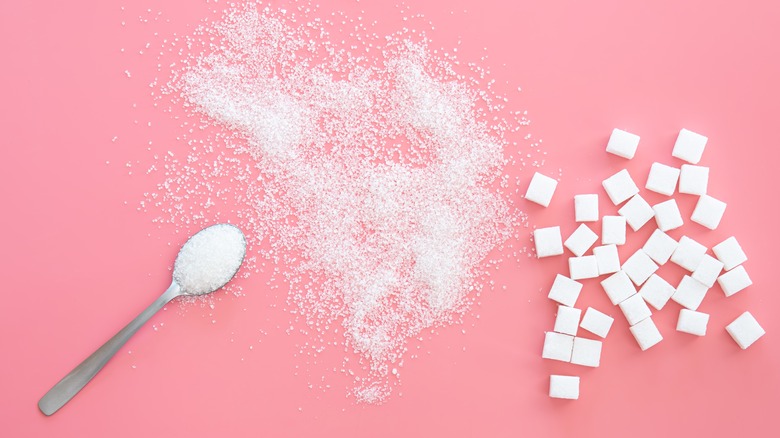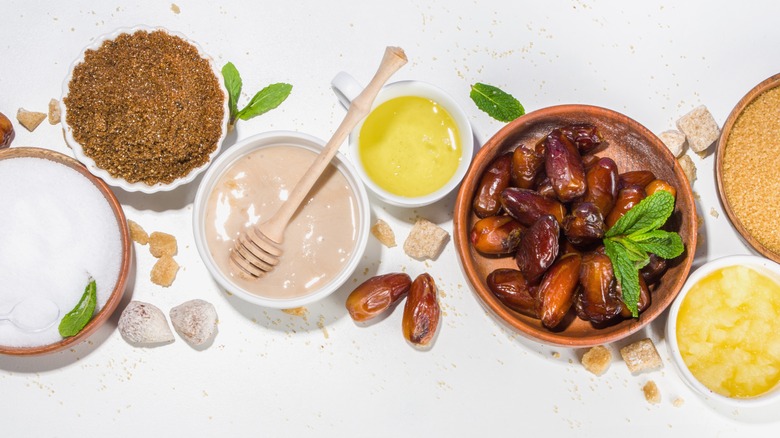The Lengthy History Of Sugar
Sugar is part of all of our lives. It's been part of the human diet for millennia, and it's found in such a variety of food products that you may often not even know when you're consuming it. Its history is complex and has had serious implications for individual and public health as well as global economics. In fact, sugar was a documented financial commodity before almost anything else (via the Sugar Association). It was once so valued that it would even be locked up for safety.
Globally, sugarcane is today still the third most valuable crop. Americans consume, on average, over 17 teaspoons of the sweet stuff every day (via National Geographic). Sugar carbohydrates are the primary source of caloric energy that fuels the human body. Scientists theorize that we are actually hardwired to love sugar, since our evolutionary survival instincts are geared toward the high energy content of fruits, berries, and honey — which could have meant the difference between surviving and starving in the past.
Cross-cultural origins
According to the Sugar Association, the consumption of cane sugar is believed to have originated roughly 10,000 years ago in Papua New Guinea before eventually spreading around the world. In the sixth century B.C., Emperor Darius of Persia described it as "the reed which gives honey without bees" (via Sugar Knowledge International Ltd). Arab conquerors invaded Persia in the seventh century A.D., discovered the sugar process being used, and implemented it in other conquered lands like Spain and parts of Northern Africa.
Sugar was brought to the West through the Crusades, was sold in London by the 1300s, and is known to have been refined in Venice, Italy, in the 1400s. Christopher Columbus brought sugarcane to the Caribbean to be grown in 1493. By 1750, sugar was referred to as "white gold" by the British, who ran over 100 sugar refineries by that time. During the Napoleonic Wars, they cut off cane sugar supplies from the West Indies, which led to the beet sugar industry's creation (via the Sugar Association). Beet sugar became commonly used in Europe. The United States caught up in terms of beet sugar production, and today, sugar beets supply around 4.5 million tons of sugar in the U.S.
Sugarcane cultivation was further modernized in the 1930s by the use of whole-stalk harvesters in Louisiana. Today, sugarcane is grown all around the world and is consumed at a rate of over 100 million tons annually.
Colonial sugar plantations and slavery in the New World
As Europeans brought sugar to the New World, sugarcane plantations developed in the Caribbean, North America, and South America, turning large profits for those who exploited enslaved people brought to the plantations (via the National Museum of American History). Tall sugarcane plants needed to be cut with double-edged knives, transported to mills, processed, blocked, packaged into barrels, rolled away, and shipped. Sugar production required treacherous, heavy labor, which was fueled by an ongoing supply of enslaved people taken from Africa. "The true Age of Sugar had begun — and it was doing more to reshape the world than any ruler, empire or war had ever done," historians Marc Aronson and Marina Budhos wrote in "Sugar Changed the World" (via The New York Times).
Plantation systems also required the extremely physically taxing labor of field clearing and burning, fertilization, irrigation, planting, weeding, harvesting, and cart loading, which required day-and-night labor. Historian A.R. Disney called sugar production "one of the most complex and technologically-sophisticated agricultural industries of early modern times" (via World History Encyclopedia), and the machinery, including presses, windmills, and water mills, were operated by enslaved people, who were also made to log timber for fuel.
Around a fifth of captive Africans died during the Atlantic journey, but those who survived were generally physically tortured, stripped of language and culture, given limited and unvaried nutrition and rudimentary housing, and had a short life expectancy.
The American Sugar Refining Company and the Domino Sugar Refinery
The Domino Sugar Refinery, which operated in Brooklyn's Williamsburg neighborhood for over 150 years, was built by the wealthy Havemeyer family's Sugar Refineries Company in 1855 and went on to become the largest industrial sugar factory in the world (via Smithsonian Magazine). The Domino Sugar Refinery was processing over half of American sugar by the 1920s, close to 4 million pounds a day. The factory closed in 2014 and was photographed by famed industrial and urban photojournalist Paul Raphaelson before eventually being partially demolished and made into a housing and commercial office project (via The Atlantic).
Referred to as the "jewel in the crown" of Domino's sugar empire, the refinery was responsible for producing 98% of the sugar used by Americans in its heyday (via Domino Park). At one time, the Sugar Refineries Company had such a monopoly on sugar that the federal government eventually broke it up. The Domino Sugar Factory was also home to the largest wage strike in New York City's history. The building symbolizes a unique era in terms of food, industrialization, immigrant work history, New York City, and labor movements.
Dental issues emerge
Dental issues have always existed in humans but increased dramatically with the increased availability of sugar. History makes this clear when it comes to the condition of wealthy people's teeth. The cost of processing and cultivating sugar used to mean only families with the most money could eat sugar and sugary treats often. When experts examined the remains of Anne Wolseley Calvert, a colonial governor's wife who died in 1680, they found that despite silk finery and a lead coffin, her teeth were decayed to the roots due to sugar consumption (via Paul Revere House). Remains of servants from the same century show no such dental decay.
In the era of George Washington, Americans consumed around 6 pounds of sugar annually, as opposed to the average 130 pounds per year that Americans consume today (via Smithsonian Magazine). The ubiquitous availability of sugar in modern processed foods presents particular health and dental concerns for the poor. A lack of easy access to whole foods and produce means increased sugar intake in the form of packaged, processed food products — meaning that while the wealthiest once suffered the worst tooth decay, the poorest are now the most vulnerable to the ailment today. Globally, the World Health Organization (WHO) cites dental caries as the most common noncommunicable disease and a major public health concern, one that is largely preventable through reducing the intake of added sugar.
World War II and sugar rations
The World War II era saw the U.S. federal government mandating rations on various foods and supplies (via The National WWII History Museum). Every citizen was granted a certain number of points which could be put toward grocery items. Food ration stamps were submitted along with money to purchase items. Sugar was the first item rationed and the only to continue to be rationed after 1946 (via the USDA). Sugar was needed for soldiers and was also a component in antiseptics and even explosives. On top of that, routes to cane fields were being cut off in combat, according to Smithsonian Magazine.
The American government provided soldiers with ample sugar compared to civilians, according to the Saturday Evening Post. Nonetheless, records show that when Navy servicemen were able to buy extra food supplies beyond their rations, they went for candy almost half the time. The war-era sugar rations lasted five years, from 1942 to 1947. Everyone was instructed to pitch in for the greater good by sacrificing sugar intake. Housewives were told to use extra canned fruit syrup to sweeten baked goods.
Corn syrup, sugar, and big business
The 1960s saw the introduction of high fructose corn syrup into the American diet, and American consumption of high fructose corn syrup increased tenfold between 1970 and 1990, according to National Geographic. The lack of any nutrients in fructose, however, means that this increased use of empty calories contributed to the rise of American obesity. Fructose is not metabolized the way sugar glucose is and produces fat molecules and taxes the liver. Corn syrup use was fueled in part due to corn being subsidized by the federal government and also an effort by large corn-processing companies to utilize excess product (via Mother Jones).
The story of America's love affair with sweetness is interwoven with darker financial interests. As reported by HuffPost, evidence indicates that the power players of the sugar industry lined Harvard University scientists' pockets to ensure they suppressed clear evidence of sugar's detrimental health effects. Food research has also been impacted by big business interests. Research suggests that yearly, 184,000 deaths worldwide are due to sugary drink-related diabetes, cancer, or cardiovascular disease, yet Pepsi and the American Beverage Association have funded research denying a correlation between sugary drinks and obesity.
Sugar-related health risks
Sugar is a naturally occurring element present in fruit, vegetables, grains, and even dairy. Because these foods are full of fiber, proteins, and other nutrients, the body breaks them down slowly, and the organic sugars present are absorbed slowly (via Harvard Health). Added, man-made sugars, however, are processed quickly, spiking blood sugar and leading to shifts in blood pressure, insulin levels, and hormones. A high-sugar diet is linked to chronic inflammation, heart disease, diabetes, liver disease, kidney disease, obesity, and even cancer.
Sugar consumption is an evolutionary drive for humans. Sugar in fruits and honey could provide a burst of energy that might have ensured our ancestors' survival. However, naturally occurring sugar was limited by availability and season until sugar production began. The World Health Organization (WHO) recommends limiting sugar intake due to public health concerns, but it's no easy task for most people because, beyond sweetness, sugar briefly boosts the activity of the neurochemical dopamine, which in turn leads to increased levels of mood-elevating endorphins (via Psychology Today). Sugar consumption, however, comes with potentially deadly risk in terms of diabetes, heart pathology, and cancers. On top of that, according to William Dixon, M.D., a physician and professor of emergency medicine at Stanford University, "persistent high blood sugars can damage the vessels that supply blood to vital organs, which can increase the risk of heart disease, stroke, kidney disease and vision and nerve problems" (via Forbes).
The sugar blues: impacts on the brain
The brain requires glucose to function. According to Harvard Medical School, without sufficient glucose, neurotransmitters can't function properly, impairing memory, learning, and cognition. "The brain is dependent on sugar as its main fuel," explained Dr. Vera Novak, an associate professor of medicine at Beth Israel Deaconess Medical Center. "It cannot be without it." Too much glucose, however, has been linked to expedited signs of neurological aging, including memory and cognition deficits. Type 2 diabetes is also linked to accelerated brain aging.
According to experts, sugar can also have negative impacts on our mental health (via Psychology Today). As spikes in glucose affect blood sugar, they also alter hormones levels and mood-affecting neurochemicals. Research has suggested links between sugar and depression, as well as the intensity of schizophrenia symptoms. Researchers at Yale have published work on how sugar may activate the dopamine reward systems, similarly to a number of illicit drugs (via the LA Times). Other research has indicated a connection between sugar and anxiety symptoms (via Psychology Today).
Sugar today: alternative sugar market
The United States produces roughly 9 million tons of sugar a year (via The New York Times). The Louisiana sugar industry alone is worth $3 billion and employs over 16,000 people. However, food industry sales statistics show a clear shift in consumer interest toward sugar-free confectionery products and sweeteners (via MENAFN). According to MarketWatch, data indicates that over 90% of U.S. consumers are willing to pay more money for healthier food products. The sugar substitutes market is projected to produce multi-millions in revenue by 2028.
Sugar alternatives are sweet but present fewer health risks with fewer or no calories. Be aware, however, that alternative chemical or "artificial" sweeteners may still present some potential health risks, according to Johns Hopkins Medicine. Natural or plant-based sweeteners may contain fiber and have a lower glycemic index than sugar, but remember that they should still be consumed in moderation.
